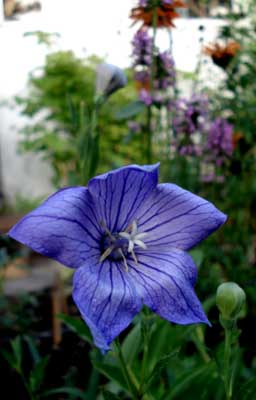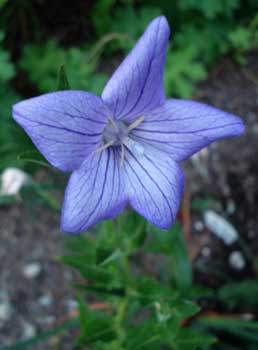
'Fuji Blue'
Balloon Flower
"O may the happier lot be ours,
To live, not with, but thro' our flowers,
That soothe our griefs, inspire our powers."
-Elaine Goodale Eastman
(1863 - 1953)
(1863 - 1953)
 Platycodon grandiflorus 'Fuji Blue' is the standard blue balloon flower cultivar. It's one of the larger varieties clumping to two feet high & wide. It will do nicely in bright shade, but tends to get a little tippy, whereas in full sun it has sturdier flower stems.
Platycodon grandiflorus 'Fuji Blue' is the standard blue balloon flower cultivar. It's one of the larger varieties clumping to two feet high & wide. It will do nicely in bright shade, but tends to get a little tippy, whereas in full sun it has sturdier flower stems.Exceedingly hardy with a very fine clear blue color, it'll last in the garden for many years, its taproot getting larger & thicker & the overall clump increasingly dense for foliage, covered over with blossoms June to first frost.
Buds famously develop into bright blue balloons before bursting open. Individually the open flowers don't last long, but there are always numerous more developing through a long period. The spent flowers collapse & wilt & can be picked off to increase floriferousness, or allowed to go to seed.
Balloon flowers were evidently first introduced into Europe in 1782, but were not well enough distributed & soon vanished from European cultivation. In 1843, famed Scottish plantsman Robert Fortune sent seeds to London from China, & it's been cultivated ever since.
In Japan the balloon flower is called Kikyo, meaning "Pentagram." The pentagram is a "balloon flower seal" with mystical significance, an important symbol in Taoism because each of the five bellflower petals represents the "five elements" of the Tao, namely wood, fire, earth, metal, & water.
It was also a symbol of the medieval Japanese onmyoji (a diviner presumed to have great mystical powers) named Abe no Seimei. He really lived in the Heian Period, but his history is inextricably knotted up with fantasy & folklore that assumes to he was an actual master of sorcery. He's the subject of sword & sorcery feature films I review here.
Continue to:
Platycodon grandiflorus 'Astra Blue'